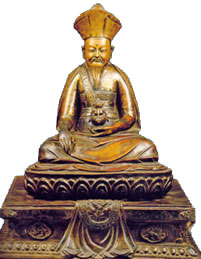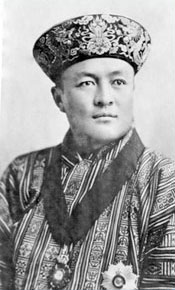History
Before Shabdrung Ngawang Namgyal Rinpoche’‘s arrival to Bhutan, numerous clans ruled in different valleys of Bhutan, having internecine war and quarrel among themselves and with Tibet. The arrival of Zhabdrung Nawang Namgyal is considered as the most significiant era in the history of Bhutanese. Shabdrung literally means, “at whose feet one submits”. Over the next thirty years, he unified the country under his central leadership, which otherwise was fragmented into petty principalities, ruled over by the tribal feudal chiefs. Shabdrung established himself as the country’s supreme leader. He ruled over Bhutan for thirty-five years until his retirement in 1651 A.D. During his reign of 35 years, he built dzongs (fortress), monasteries, and religious institutions. He established the Drukpa Kargyupa school of Tantric Mahayana Buddhism in Bhutan. His reign was marked by the introduction of the unique dual system of governance called the Chhoesid. This new system was characterized by the sharing of power and authority between the Deb Raja or the Desi who was the head of secular affairs and the Dharma Raja or the spiritual head, called as Je Khempo . He also codified laws for the country. The laws were based on medieval theocratic principles called the Tsa-Yig. The successive ‘Dharma Rajas’ were the incarnations of the Shabdrung whereas the post of the Deb Raja was like that of the Prime Minister. In course of time, the Dharma Rajas preferring religious matters withdrew themselves into seclusion while the Deb Rajas consolidated their authority exercising sole responsibility over the secular affairs. The dual form of governance continued until the birth of the Wangchuk dynasty and establishment of hereditary Monarchy in 1907. Ugyen Wangchuck was elected as the first hereditary monarch of Bhutan on December 17, 1907. The present King Jigme Singye Wangchuck is the fourth hereditary king.The seventh and eighth Zhabdrung reincarnates ( avtars) died in 1931 and 1953
The first king Gongser Ugyen Wangchuck was born in 1862 as Desi Jigme Namgyel’s first king of bhutansecond son. From an early age he had shown his capacity and his father groomed him to be his successor. At the age of 17, he became Dzongpon of Paro. Three years after becoming Paro Dzongpon, his father died suddenly and he took over his father’s position. He could fall back on a tightly knit net of relations. Nevertheless, he needed to battle various opponents to ensure the consolidation of this power, before he could leave behind his father’s way and methods. Ugyen Wangchuck tried to unite and bring peace to the country with a policy of harmony and agreement, which he finally also managed. After three years as Bhutan’s most powerful man he introduced a turning-point into Bhutan’s history: for the first time since the 17th century peace reigned in the country. Thanks to his diplomatic skills Ugyen Wangchuck also started to play an important role in the large-scale politics of South Asia. He offered to mediate in the conflict between Tibet in the north and the British in the south. This mission earned him respect from both sides, but especially from the British. For his mediation, the outcome of which was not to England’s disadvantage, he was awarded the insignia of a “Knight Commander of the British Empire” in 1903.
When King Jigme Wangchuck ascended to the Bhutanese throne in 1926, he was only 21 years old, thus only two years older than the kingdom. His father had raised him as successor, but also had him work with other personnel at court. He had received a strict, traditional Buddhist education, but had also learned English and Hindi. In 1922 he was appointed Chief of Protocol (drönyer) of Tongsa. In the same year he married his cousin Ashi Phuntsho Chöden. A year later he became Governor of Tongsa, and official heir to the throne. In 1927 he was crowned king in the presence of the former Desi and then present Je Khenpo, Chogley Yeshey Ngodrup, a reincarnation of the Shabdrung. In 1932 the King took his sister-in-law, Ashi Pema Dechen, as second wife. The beginning of Jigme Wangchuck’s reign was not without problems. Trouble came from the people who could be the most dangerous to the young monarchy – the reborn Shabdrung* and his family, whose mother especially incited the reincarnated Shabdrung to vie with the king in secular matters. Those surrounding the king blamed the Shabdrung of trying to harm the monarch with black magic. Matters came to a head in 1931, with the Shabdrung’s brother’s visit to India, where he is alleged to have sought Gandhi’s help in restoring theShabdrung’s secular powers. Shortly afterwards, in November 1931, the Shabdrung died young in Talo monastery. No relevant rebirth was to follow, and also his own descendants were no threat to the monarch. fter this troubled early period, King Jigme Wangchuck’s reign was marked by stability, political reorganisation inside the country and a considerable reduction of taxation for the population. When the king died in 1952, he left his heir a stable, unified and independent country where reforms were gradually taking place. With such firm foundations, it was up to the third king, Jigme Dorje Wangchuck, to open Bhutan to the world and launch it on the path of development.
King Jigme Dorje Wangchuck is seen as the father of modern Bhutan. From an early age on
, he was prepared for the throne. Like his father, he was educated according to Buddhist principles and learned English and Hindi; added to this, as a child, he also had insights into the etiquette of the court and the administration of the country. He was appointed chief of protocol (drönyer) of Tongsa at fifteen, but his father thought that his heir had to broaden his horizon and also get to know the Western world. Soon after his appointment, therefore, Jigme Wangchuck sent his son to England for six months. On his return, Jigme Dorje Wangchuck worked as attendant to his father, and was therefore wel l prepared to take over the kingdom when his father died in 1952. In contrast to his father and grand-father, Bhutan’s third king did not keep his country secluded from the world any longer. On the contrary, he looked for international political acceptance and contacts, on the one hand, and, on the other, asked small European states to join the Bhutanese government in developmental projects in the country. The third king set up national assembly in 1952 and took major developments for the country, from infrastructure developments to social services. As the third king was the one to lead Bhutan onto the path of modernisation and development, his people have rightfully given him the nick-name of “Father of modern Bhutan”. He died age of 44 in 1972
Born in 1955, king Jigme Singye Wangchuck already ascended the throne at the age of 17, because his father died very young. The formal, and very impressive, coronation took place two years later, on 2 June 1974, in the presence of not only the whole Bhutanese clergy and aristocracy, but also guests from all over the world. As king, Jigme Singye Wangchuck did not want to leave his country anymore. Therefore, a teacher was asked to come from England so that the young ruler would, next to his traditional Buddhist education, also receive the input that would open his eyes onto the world beyond Bhutan’s borders. This familiarity with both worlds forms the fourth monarch’s politics: he aims at the socio-economic development of the country without neglecting the traditions of his forefathers and their cultural inheritance. In an interview with the »Financial Times« the king himself has once pointedly expressed the motto of his developmental politics: to him the “Gross National Happiness” is of more importance than the “Gross National Product”The path continued In the cultural self-esteem and national identity of his subjects, the monarch recognises the possibility of Bhutan’s survival as dwarf between its gigantic neighbours in the South and the North. A society built on religious values should be able to resist the threats and dangers of the process of globalisation. Since 1961 five-year plans have guided the material growth, focusing on the construction of roads, communication, health care, education and agriculture. The financing of social infrastructures has so far mainly been carried by the international developmental cooperation. In order to become independent of such help, it is necessary to increase agricultural and industrial production, tourism and, most importantly, the use of the immense potential of water power. Since this can only be done by increasing the exploitation of nature, it will have to be protected more than in the past.





